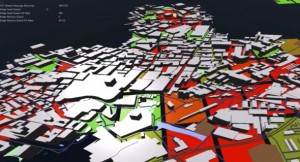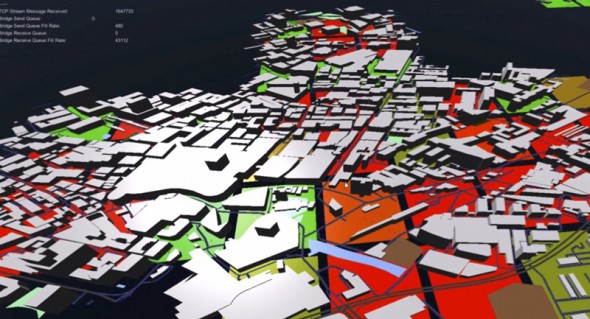
Highly Detailed City Simulation is the New Autonomous Taxi Dispatch
Few would dispute the idea that autonomous cars could cut costs and improve efficiencies. But they would present new problems, too—and not only for the displaced workforce. How, for example, does a taxi firm optimally direct its self-driving cars to ensure that its vehicles are best distributed through a city?
It’s a question that Immense Simulations, a British startup, hopes to solve using Improbable, a simulation technology initially developed for the video game industry. Improbable uses the combined power of thousands of public servers to create real-time simulations of vast and detailed virtual worlds.
In the past 12 months, Improbable has scaled up its operation, increasing the number of public cloud infrastructure services that any one simulation can draw upon. This enables finely detailed simulations including, for example, the creation of a digital 1:1 replica of a real-world city, including all of its roads, buildings, and power and Web networks.
It has allowed Immense Simulations to create a full simulation of Manchester, a city in the north of England with more than 100,000 residents and a spaghetti tangle of roads.
 Improbable’s technology creates a real-time replica of a city, including all of its roads, buildings, and power and Web networks.
Improbable’s technology creates a real-time replica of a city, including all of its roads, buildings, and power and Web networks.
“Improbable’s technology allows us to run city-scale scenario simulations with a level of detail not previously possible,” says Robin North, CEO of Immense Simulations. “We can represent individual travelers and vehicle operations and their interactions within a living city.”
The model of Manchester is based on licensed real-world data. Immense, which recently received a share of a £20 million ($29 million) U.K. government grant to develop the next generation of autonomous vehicles and infrastructure, is now working to create models of other major cities around the world. The aim is to allow companies with fleets of autonomous cars to anticipate the optimum distribution of their vehicles in advance.
“We simulate the varying demand for travel throughout a typical week,” says North. “This allows us to better estimate travel times on different routes, and work out where vehicles will need to be to best serve their customers.”
The simulation is able to show the immediate effects of accidents on traffic flow. “The simulation is run continuously but with a short time horizon, in order to predict the short-term consequences of vehicles’ immediate actions,” says Herman Narula, Improbable’s CEO and cofounder. “Existing tools can’t provide this kind of insight. Big data can extrapolate trends from the past, but can’t model complex systems with emergent and possibly chaotic behavior.”
Anticipation for the work is high. British transport secretary Patrick McLoughlin says the project should help “profoundly change the way we travel,” by “reducing accidents and helping traffic flow more smoothly.”
Improbable’s technology, called SpatialOS, was initially created to serve the video game industry, allowing for the creation of more intricate and persistent online worlds for players to explore. It’s becoming clear that the technology could be useful for a much broader set of simulations.
“Representing a city as a persistent, continuously updating, virtual world is a game-changer for us,” says North. “The technology has solved a set of issues for us around how to retain more detail in our simulations while representing millions of people, vehicles, roads, and buildings, and the changes they undergo every day.”
The collaboration between Improbable and Immense is just one example of the real-world applications for simulation technology around energy, city efficiency, health, and finance. Another project, recently commissioned by the U.K. government, involves simulating the underlying infrastructure of the Internet in real time in order to highlight security weaknesses.
“The backbone of the Internet is built of approximately 60,000 autonomous systems, such as ISPs, that operate independently of each other, but together have the information to route traffic between any connected device,” says Narula.
Using real data about this routing between real autonomous systems, the researchers effectively created an “Internet in a box,” as Narula puts it. The simulation is able to model changes in connectivity, such as an intercontinental fiber-optic cable being cut by accident, or a totalitarian government shutting down access to an entire country, or a rogue ISP redirecting traffic for inspection, showing the potential effects.
“This [work] can help governments protect their infrastructure by identifying and analyzing potential weaknesses ahead of time, by running ‘war games’ against their own infrastructure to be better prepared in case of an incident,” says Narula.

Leave a Reply